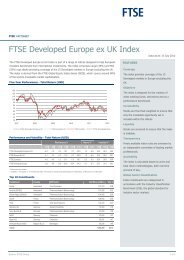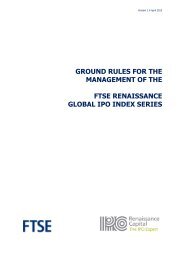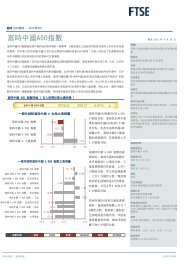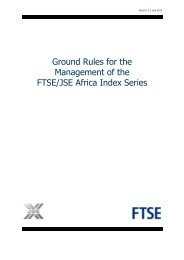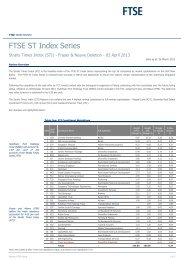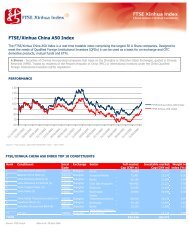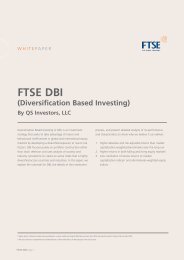Create successful ePaper yourself
Turn your PDF publications into a flip-book with our unique Google optimized e-Paper software.
CDOs trace their origins to the late 1980s but the market<br />
really took off in 1996; (see, for example, data for CDOs<br />
rated by Moody’s in Figure 1: CDOs: Dramatic Growth to<br />
Record Levels in 2004).The early transactions were cash flow<br />
CDOs that allowed financial institutions to lay off credit<br />
risk through repackaged high-yield bonds but the structure<br />
soon spread to other asset classes. In today’s market, the<br />
assets most commonly securitised are high yield corporate<br />
loans and asset backed securities, but collateral extends<br />
from investment grade bonds to bank and insurance<br />
company preferred stocks and real estate.<br />
Cash flow CDO transactions dominated the market in<br />
the United States until the past couple of years, according<br />
to Drew Dickey, managing director and head of the<br />
structured credit team at Babson Capital Management,<br />
LLC. The absence of actively traded cash collateral bred a<br />
synthetic market in Europe, where credit risk was<br />
concentrated in banks rather than bonds. A synthetic CDO<br />
holds high quality near cash collateral and adds credit<br />
exposure through a portfolio of credit default swaps, which<br />
are effectively put options on default risk.<br />
CDOs challenge the efficient market hypothesis: why will<br />
investors pay more when the overall risk in a CDO equals<br />
the sum of the risks in its collateral portfolio? The structure<br />
adds value by facilitating the transfer of credit risk. Bill May,<br />
a managing director in Moody’s derivatives group, cites<br />
CDOs based on middle market bank loans as an example.<br />
The individual loans are relatively small and unrated; an<br />
institutional investor cannot afford to monitor enough<br />
companies to build a diversified portfolio. The lenders, who<br />
do track the companies, repackage the loans into CDOs,<br />
although they retain some exposure to each loan so<br />
investors know the sponsor has some skin in the game if a<br />
loan goes bad. In effect, CDO investors outsource the credit<br />
research and monitoring.“It gives investors an opportunity<br />
to invest in an asset class that they could never do on their<br />
own,”says May,“And it gives these small companies access<br />
to capital they could otherwise never get.”<br />
Artificial restrictions that require many investors to hold<br />
only rated instruments contribute to the repackaging<br />
arbitrage. “These portfolios are fairly diverse,” says Sivan<br />
Mahadevan, executive director and head of structured<br />
credit research at Morgan Stanley,“You can get investment<br />
grade ratings for a lot of the tranches that have even a little<br />
bit of subordination.” Rated CDO tranches command a<br />
premium because they appeal to a broader market.<br />
Senior CDO tranches find a home among pension funds,<br />
insurance companies, banks, and conduits set up by banks<br />
that use the high-quality assets as collateral to support<br />
commercial paper issued to money market mutual funds<br />
and other cash market investors. The mezzanine notes go<br />
to insurance companies, banks, mutual funds and hedge<br />
funds. <strong>Equity</strong> tranches appeal to banks and insurance<br />
companies looking for assets that offer leveraged returns<br />
relative to their regulatory capital requirement. Other<br />
investors willing to accept the risk (including hedge funds)<br />
buy equity for the high potential return.<br />
<strong>FTSE</strong> GLOBAL MARKETS • JULY/AUGUST 2005<br />
Drew Dickey, managing director and head of the structured credit<br />
team at Babson Capital Management<br />
CDOs challenge the efficient market<br />
hypothesis: why will investors pay more<br />
when the overall risk in a CDO equals<br />
the sum of the risks in its collateral<br />
portfolio?<br />
The allocation of losses in a CDO pool turns the equity<br />
and mezzanine tranches into leveraged plays on default<br />
risk – with price volatility to match. Hedge funds<br />
compounded that volatility by trading on margin. When<br />
the expected correlation between the equity and<br />
mezzanine tranches broke down, margin calls loomed as<br />
funds faced mark-to-market losses on both sides. “If you<br />
buy something on mark-to-market leverage you tend to<br />
give up the freedom to have your own view of the world,”<br />
Babson Capital Management’s Dickey says, “You can<br />
think that pricing is completely absurd. It might be absurd.<br />
But that doesn’t really matter when you have to put up<br />
more collateral.”<br />
In theory, correlation refers to the probability that if one<br />
credit in a CDO pool defaults other credits will also default.<br />
In practice, correlation is not a measurable input to the<br />
pricing model, according to Dickey. Companies don’t<br />
default often enough to generate reliable data on credit<br />
75



